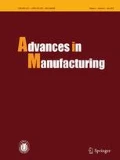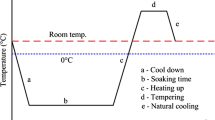Abstract
The functionally graded cemented tungsten carbide (FGCC) is a suitable material choice for cutting tool applications due to balanced hardness and fracture toughness. The presence of cobalt and CaF2 composition gradient in FGCC may enhance mechanical as well as antifriction properties. Therefore, structural design of self-lubricating FGCC was proposed using Power law composition gradient model and thermal residual stresses (TRSs) as a key parameter. Wherein, S. Suresh and A. Mortensen model was adopted for estimation of TRS, and optimum composition gradient was identified at Power law exponent n = 2. The designed material displayed compressive and tensile TRS at surface and core respectively; subsequently fabricated by spark plasma sintering and characterized via scanning electron microscope (SEM), indentation method. The agreement between experimental and analytical values of TRS demonstrated the effectiveness of intended design model in the composition optimization of self-lubricating FGCC. This work will be helpful in implementation of dry machining for clean and green manufacturing.







Similar content being viewed by others
References
Zhang FL, Wang CY, Zhu M (2003) Nanostructured WC / Co composite powder prepared by high energy ball milling. Scr Mater 49:1123–1128
Xu CH, Wu GY, Xiao GC et al (2014) Al2O3/(W, Ti) C / CaF2 multi-component graded self-lubricating ceramic cutting tool material. Int J Refract Met Hard Mater 45:125–129
Liu H, Xue Q (1996) The tribological properties of TZP-graphite self-lubricating ceramics. Wear 198:143–149
Klocke F, Eisenblatter G (1997) Dry cutting. Ann ClRP 46(2):519–526
Jianxin D, Tongkun C, Lili L (2005) Self-lubricating behaviors of Al2O3 / TiB2 ceramic tools in dry high-speed machining of hardened steel. J Eur Ceram Soc 25:1073–1079
Sreejith PS, Ngoi BKA (2000) Dry machining: machining of the future. J Mater Process Technol 101:287–291
Feng Y, Zhang J, Wang L et al (2017) Fabrication techniques and cutting performance of micro-textured self lubricating ceramic cutting tools by in-situ forming of Al2O3-TiC. Int J Refract Met Hard Mater 68:121–129
Wu G, Xua C, Xiao G et al (2018) Structure design of Al2O3/TiC/CaF2 multicomponent gradient selflubricating ceramic composite and its tribological behaviors. Ceram Int 44:5550–5563
Gong F, Zhao J, Li Z et al (2018) Design, fabrication and mechanical properties of multidimensional graded ceramic tool materials. Ceram Int 44:2941–2951
Muthuraja A, Senthilvelan S (2015) Adhesive wear performance of tungsten carbide based solid lubricant material. Int J Refract Met Hard Mater 52:235–244
Muthuraja A, Senthilvelan S (2015) Abrasive wear performance of tungsten carbide based self-lubricant cutting tool material. Int J Refract Met Hard Mater 51:91–101
Singh T, Gangil B, Patnaik A et al (2019) Physico-mechanical, thermal and dynamic mechanical behaviour of natural-synthetic fiber reinforced vinylester based homogenous and functionally graded composites. Mater Res Express 6:025704
Abedi T, Khameneh Asl S (2019) Synthesis of a novel functionally graded coatings of Ni-Cr/Al2O3 nanocomposite coating by pulse electrodeposition. Mater Res Express 6:056403
Xu C, Xiao G, Zhang Y et al (2014) Finite element design and fabrication of Al2O3/TiC/CaF2 gradient self-lubricating ceramic tool material. Ceram Int 40:10971–10983
Xing A, Jun Z, Huang CZ et al (1998) Development of an advanced ceramic tool material—functionally gradient cutting ceramics. Mater Sci Eng A 248:125–131
Muthuraja A, Senthilvelan S (2015) Development of tungsten carbide based self lubricant cutting tool material: preliminary investigation. Int J Refract Met Hard Mater 48:89–96
Deng JX, Liu LL, Yang XF et al (2007) Self-lubrication of Al2O3/TiC/CaF2 ceramic composites in sliding wear tests and in machining processes. Mater Des 28:757–764
Parihar RS, Setti SG, Sahu RK (2018) Preliminary investigation on development of functionally graded cemented tungsten carbide with solid lubricant via ball milling and spark plasma sintering. J Compos Mater 52(10):1363–1377
Parihar RS, Setti SG, Sahu RK (2018) Recent advances in the manufacturing processes of functionally graded materials: a review. Sci Eng Compos Mater 25(2):309–336
Kumar B, Mer KKS, Prasad L (2019) Dry sliding wear behaviour of aluminium metal matrix-based functionally graded materials reinforced with alumina particles. Trends Mater Eng. https://doi.org/10.1007/978-981-13-9016-6_1
Chen Z, Ji L, Guo N, Guo R (2018) Mechanical properties and microstructure of Al2O3/TiC based self lubricating ceramic tool with CaF2@Al (HO)3. Int J Refract Met Hard Mater 75:50–55
Zhao J, Ai X, Deng J et al (2004) Thermal shock behaviors of functionally graded ceramic tool materials. J Eur Ceram Soc 24:847–854
Suresh S, Mortensen A (1997) Functionally graded metals and metal-ceramic composites: part 2 thermomechanical behaviour. Int Mater Rev 42(3):85–116
Safari-Kahnaki A, Hosseini SM, Tahani M (2011) Thermal shock analysis and thermo-elastic stress waves in functionally graded thick hollow cylinders using analytical method. Int J Mech Mater Des 7:167–184
Parihar RS, Setti SG, Sahu RK (2019) Effect of sintering parameters on microstructure and mechanical properties of self-lubricating functionally graded cemented tungsten carbide. J Manuf Processes 45:498–508
Emanuelli L, Molinari A, Arrighetti G et al (2018) Effect of the sintering parameters on the liquid Co migration in WC-Co. Int J Refract Met Hard Mater 70:202–209
Ther O, Colin C, Dourfaye A (2017) Functionally graded cemented carbides elaboration by imbibition process—better understanding of liquid migration and homogenization mechanisms for an improved process. Front Mater Process Appl Res Technol. https://doi.org/10.1007/978-981-10-4819-7_10
Larsson C, Oden M (2004) X-ray diffraction determination of residual stresses in functionally graded WC-Co composites. Int J Refract Met Hard Mater 22:177–184
Acknowledgement
This work was supported by the Chhattisgarh Council of Science and Technology (CCOST) (Grant No. 2230/CCOST/MRP/15, dated 23.12.2015).
Author information
Authors and Affiliations
Corresponding author
Rights and permissions
About this article
Cite this article
Singh Parihar, R., Kumar Sahu, R. & Gangi Setti, S. Novel design and composition optimization of self-lubricating functionally graded cemented tungsten carbide cutting tool material for dry machining. Adv. Manuf. 9, 34–46 (2021). https://doi.org/10.1007/s40436-020-00312-3
Received:
Revised:
Accepted:
Published:
Issue Date:
DOI: https://doi.org/10.1007/s40436-020-00312-3




